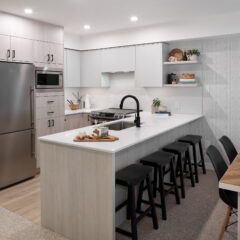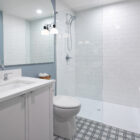The kitchen is often considered the heart of the home, and for good reason. It’s where we prepare meals, gather with loved ones, and create memories. As such, it’s important that your kitchen looks and functions at its best. One of the key components to achieving this is your countertops.
However, over time, even the most durable countertops can wear out, become damaged, or simply no longer suit your taste. When this happens, it’s time to replace them. But where do you start? In this blog post, we’ll guide you through the process of replacing and installing kitchen countertops, including selecting the right material, measuring your space and general replacement process.
Keep reading and transform your kitchen today.
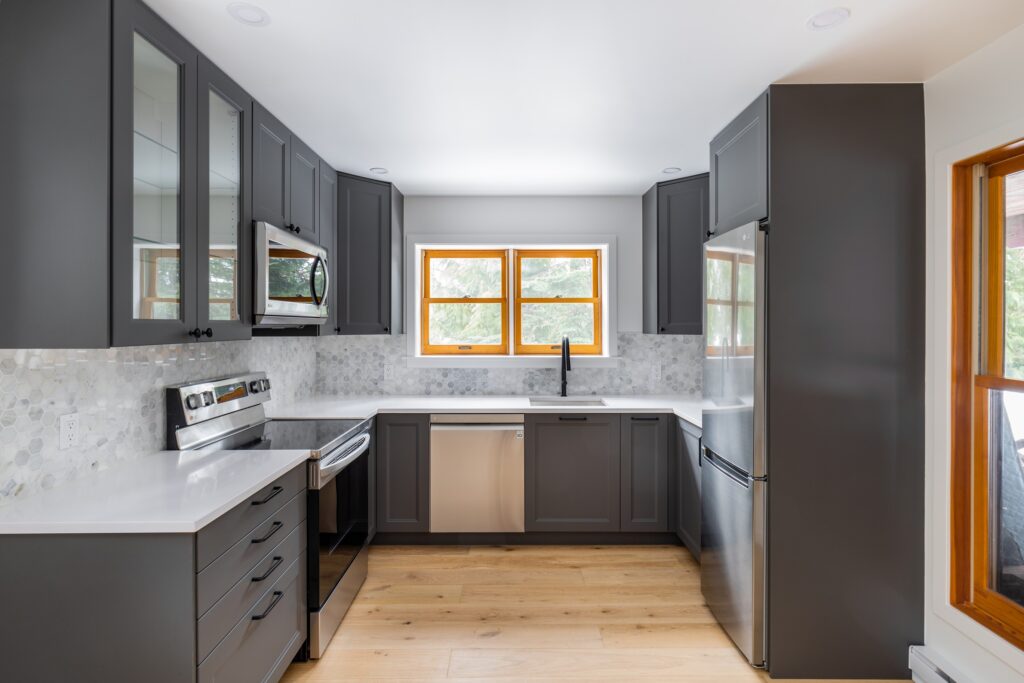
- Brighten up space
- Improve aesthetic appeal
- Improve functionality
- Improve hygiene and convenience
- Prolong durability
Benefits of replacing kitchen countertops
Replacing kitchen countertops can improve both the aesthetic appeal of your kitchen and its functionality. New countertops can brighten up any space with their clean lines and modern design, while also providing a durable and long-lasting surface that is ideal for prepping meals or entertaining guests.
By investing in new countertops now, you can reap the rewards for years to come in terms of improved hygiene and convenience. Not only will you be able to enjoy all the beauty of your new kitchen, but you’ll also have peace of mind knowing that your counters are resistant against everyday wear-and-tear!
Building your dream home is about desire and fantasy, but it’s achievable; anyone can do it
KEVIN MC CLOUD
What to consider when replacing kitchen countertops
Replacing countertops can be a significant home improvement project, and there are several considerations to keep in mind before starting the process.
Budget: Countertop materials can vary greatly in price, so it’s essential to determine your budget before choosing a material.
Material: There are many different types of countertop materials available, including granite, quartz, marble, laminate, and wood. Consider hiring a designer to help you understand the context of the changes you’re making.
Functionality: Consider how you use your countertops and what features are important to you.
Installation: Are you making huge and complex changes? Professional will probably serve you better.
Timeframe: Replacing countertops can take several days or even weeks, depending on the materials and complexity of the project. Make sure to plan accordingly and consider any disruptions to your daily routine.
Aesthetics: Countertops can significantly impact the look and feel of your kitchen or bathroom, so it’s essential to choose a material and design that complements your existing décor and personal style. The importance of a skilled interior designer comes even more handy at this stage.
Resale value: If you’re planning to sell your home in the future, consider how your countertop choice may impact your home’s resale value. Some materials, such as granite or quartz, are more popular and may increase the value of your home.
DIY countertop replacement versus professional contractor
Did you know that, on average, it takes a homeowner only four hours to replace their kitchen countertops? While this short time-frame is great news for DIYers, when it comes to replacing countertops, there are pros and cons to both going the DIY route or bringing in a professional contractor.
When deciding between DIY or a pro, it’s important to consider the type of countertop you have, and what materials you will be using to replace them. Solid surface kitchen countertops can often be installed by homeowners without too much difficulty. This includes detaching the fasteners on the old countertop and bolting the pieces of the new one together.
On the other hand, if your current countertop requires more complicated installation methods like precise cutting or complex patterns with multiple pieces then it would be wise to bring in a pro. Professionals can also provide more options for materials and colors allowing homeowners more options when selecting their new look.
Tools needed for countertops replacement
Replacing countertops is no small feat. According to a recent survey, up to 87% of homeowners are willing to take on home renovation projects by themselves. When taking on this project as a DIYer, you’ll need some basic tools and materials.
- Measuring tape: This tool will be used to measure the size of the existing countertop and the new material to ensure a proper fit.
- Level: A level will be used to ensure that the countertop is installed flat and level.
- Power drill: A power drill will be needed to remove the old countertop and to attach the new countertop to the cabinets or supports.
- Circular saw or jigsaw: A circular saw or jigsaw may be needed to cut the new countertop to size.
- Utility knife: A utility knife will be used to cut through any caulking or adhesive holding the old countertop in place.
- Pry bar: A pry bar will be used to remove the old countertop from the cabinets or supports.
- Clamps: Clamps may be needed to hold the new countertop in place while it is being attached.
- Adhesive: Depending on the type of countertop material, adhesive may be needed to attach the countertop to the cabinets or supports.
- Safety glasses and gloves: Safety glasses and gloves should be worn to protect your eyes and hands during the countertop removal and installation process.
It’s important to note that some countertop materials may require additional tools or specialized equipment, so it’s always a good idea to check with the manufacturer or a professional installer for specific requirements.
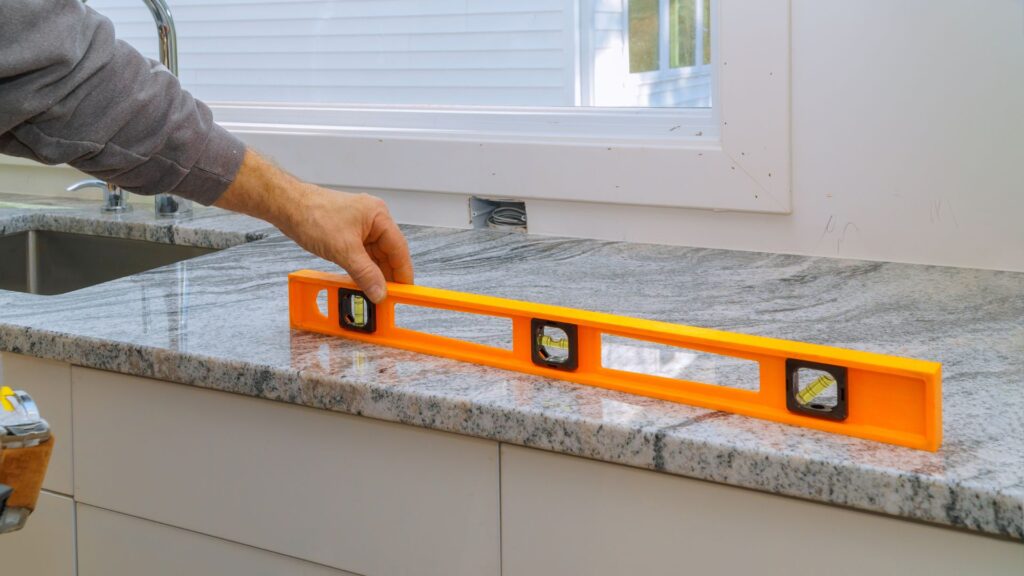
Guide to kitchen countertop materials
There are many different kitchen countertop materials to choose from, and each has its own unique advantages and disadvantages. When choosing a kitchen countertop, consider factors such as durability, maintenance requirements, and cost, as well as the overall style and aesthetic of your kitchen.
Here are some of the most popular kitchen countertop materials and their characteristics:
- Granite: A natural stone that is highly durable and heat-resistant. It comes in a variety of colors and patterns, making it a popular choice for high-end kitchens. However, it can be expensive and requires periodic sealing to prevent staining.
- Quartz: Quartz is a man-made material that is composed of natural quartz particles and resin. It is highly durable, non-porous, and requires no sealing. It can be more expensive than other materials.
- Marble: Known for its elegance and beauty. It is highly heat-resistant, but it can be easily scratched and stained, making it a less practical choice for high-traffic kitchens.
- Solid Surface: Solid surface countertops are made from a blend of acrylic and polyester materials. They are highly durable, and can be repaired if scratched. However, they can be more expensive than other materials and are susceptible to heat damage.
- Laminate: Laminate countertops are made from layers of paper or fabric that are bonded together with resin. They are highly affordable, available in a variety of colors and patterns, and easy to maintain. However, they can be easily scratched and are not heat-resistant.
- Wood: Wood countertops are warm and natural-looking. They are highly durable and can be sanded and refinished if scratched. However, they require regular maintenance, including periodic sealing and oiling, to prevent staining and warping.
- Stainless Steel: Stainless steel countertops are highly durable, heat-resistant, and easy to clean. They are often used in commercial kitchens and can give a modern, industrial look to a home kitchen. However, they can be expensive, prone to scratching, and can show fingerprints easily.
- Concrete: Concrete countertops are highly customizable and can be made in any color or shape. They are durable and heat-resistant, but they can be prone to cracking and staining if not sealed properly.
- Soapstone: Soapstone is a natural stone that is highly heat-resistant and non-porous, making it a practical choice for high-traffic kitchens. It is available in a limited range of colors and patterns and can be prone to scratching and chipping.
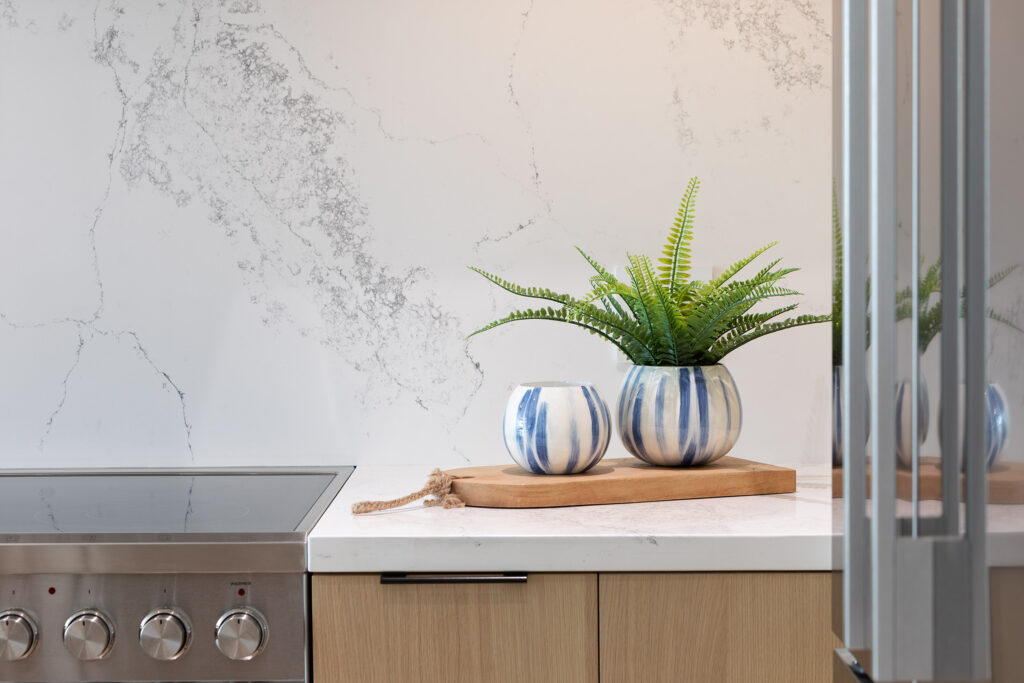
Design your new countertops
We recommend you to hire a professional designer.
They are professionals who have done this many times. They understand the context of the kitchen renovation. They see things you don’t. They can predict how certain aspects will look and be used. Designers can offer expert advice on countertop materials, colors, finishes, edge profiles, and other design elements to help you create a cohesive and functional kitchen design for years to come. Yes, designers will cost you, but you’ll be using your countertops for many years. Accept professional advice. You’ll only benefit from it.
If, after all, you decide to design your own countertop space, consider the following:
Functionality: Consider the functionality of your countertop. Will you need space for food preparation, cooking, or entertaining? Do you need a built-in sink or cutting board? Make sure your countertop design meets your specific functional needs.
Material: Choose a countertop material that fits your budget, durability needs, and design preferences.
Color: Choose a color that complements the rest of your kitchen design. Remember that there is psychology in colors. They will have a certain influence on the final kitchen vibe. Choose wisely.
Finish: Consider the finish of your countertop material. A polished finish will give your countertop a high-gloss look, while a honed or matte finish will give it a more natural, matte appearance.
Edge profile: Choose an edge profile that complements the design of your kitchen.
Thickness: Consider the thickness of your countertop. Thicker countertops can give your kitchen a more substantial, luxurious look.
Lighting: Consider how lighting will affect the look of your new countertops. If you have under-cabinet lighting, make sure it complements the color and finish of your countertop.
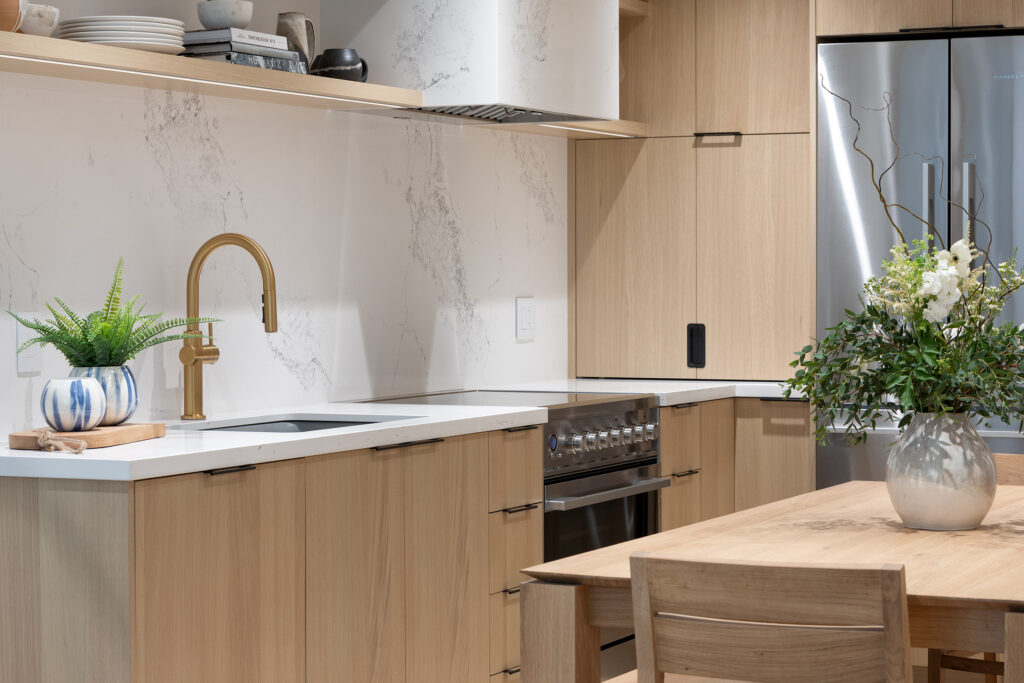
Plan the countertops replacement
Here are some steps to help you plan for the replacement and installation of kitchen countertops:
Before you start planning your countertop replacement, determine how much you can afford to spend. This will help you choose a material and design that fits within your budget.
Choose if you hire a designer or approach the kitchen countertops design yourself.
Decide whether you will hire a professional contractor to install your new countertops or if you will do it yourself.
Keep in mind that countertop installation can be a complex and time-consuming process, so if you’re not experienced with home improvement projects, it may be best to hire a professional.
How to replace kitchen countertops: The process
Remove old kitchen countertops
Taking out your old countertops is the first step in replacement. To take them out, you’ll need to detach all its fasteners – usually screws or bolts – from the cabinet frame. After that, use a file or grinder to smooth down any rough cuts left behind by the fasteners.
Measure, cut and dry fit new countertops
Once the old countertops have been removed, it’s time to start cutting and dry fitting the new ones. You should already have the right measurements from your planning phase. Double check your measurements and start cutting with a jigsaw. Try if the new countertops fit with the existing set up.
Install and secure the new countertops
If you’re working around a stove or sink, make sure to close off and detach the supply line first. Place your countertops and bolt the pieces together with either metal or plastic fasteners. Finally, seal the sink and range in place with caulk.
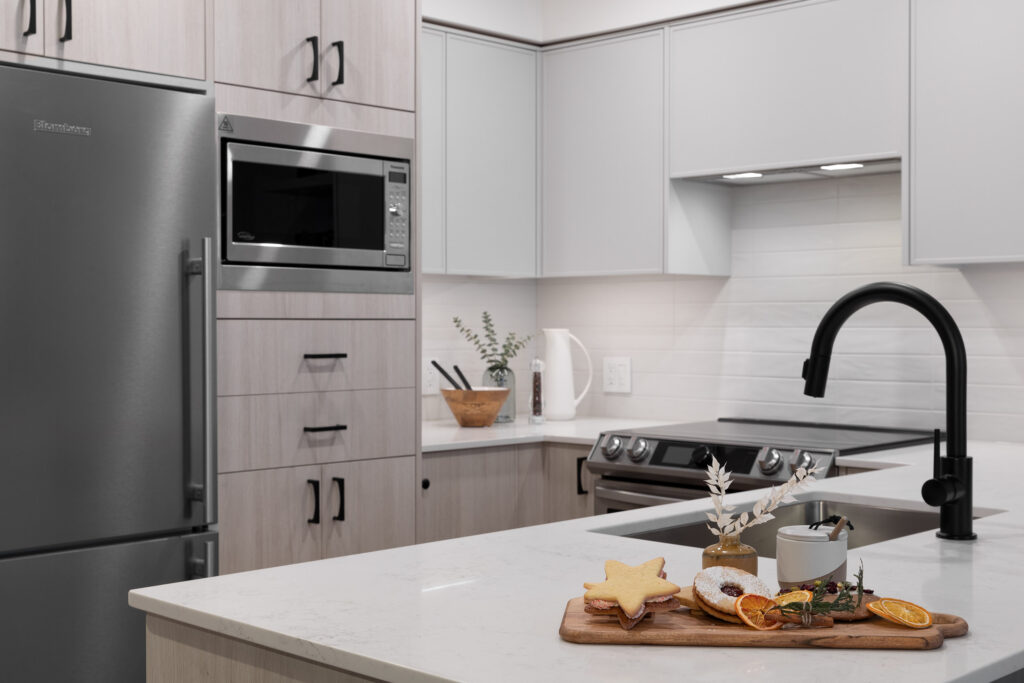
Reinstall appliances
Place your appliances back where they were. Ensure that all water and gas supply lines are securely fastened to their respective outlets so they don’t leak or get disconnected.
PRO TIP: Before reinstalling your appliances, make sure to thoroughly clean them off using a mild detergent solution to remove any grease or residue buildup. This will help keep your kitchen looking fresh and new for years to come!
Conclusion
In conclusion, replacing kitchen countertops can be an excellent way to transform the look and feel of your kitchen. Whether you’re looking to update the style of your space or simply want to replace worn or damaged countertops, there are many options available to suit your needs and budget.
From natural stone to engineered materials, the range of countertop materials available today offers a wide range of styles, durability, and price points. With the help of a professional contractor, you can select the perfect material and design to complement your existing cabinetry, flooring, and overall style.
Contact us today to schedule a consultation and learn more about how we can help you improve the comfort and value of your home.





